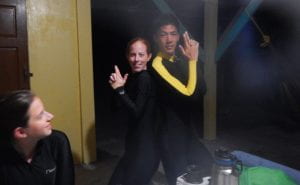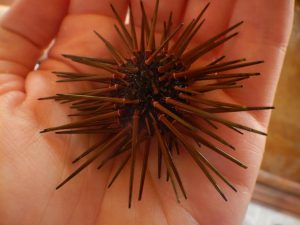May 26, 2019

Another good weather day, and another project to be done. Today we examined the difference in sea urchin community structure in and out of the marine protected zone. We decided to log the species, number of each species, and the size of individual urchins (via diameter of their round bodies called a test) at patch reefs in and outside the MPA. Our first stop was actually the MPA reef we went to on the first day. Each group was given a pair of tongs and picked a different direction to start in. We had 30 minutes to catch as many sea urchins, and as soon as Professor Solomon yelled “GO!” it was a mad dash to the coral. Scanning every nook and cranny took some time, but the urchin spines would eventually come into focus and you would have to squeeze your hand or tongs in the crevice to grab them. I grabbed several small Reef Urchins and a West Indian Sea Egg (an urchin with a large center and short white spines).
After logging the data, we released the urchins and it was onto the next site. The next site was out of the MPA, and had more Long Spined Urchins (have long black or white striped spines and are a little venomous). I also noticed a Bicolor Damselfish protecting its territory from me as I tried to un-lodge an urchin from the coral. It was quite colorful, with a yellow and black front half which fades to a white back half. This small fish, which can at max grow to a measly four inches in length, was trying to charge at me and chase me away from its patch of coral. It did not take too kindly to me trying to take a sea urchin from its home and kept flitting about, trying to get me to leave.
The day ended with a short night snorkel after dinner. Surprisingly, I felt no anxiety or trepidation when jumping into the dark water. The highlight of the night was a Spotted Eagle Ray gliding into view from the darkness. It was an eerie and ominous sight, as it seemed to just appear out of the dark. After swimming for a good while, we reached the patch reef and immediately saw multiple Spiny Lobsters out and about. There was a large trunkfish meandering across the sand, and what looked to be a Red Hare (snapper) sitting on the bottom.





